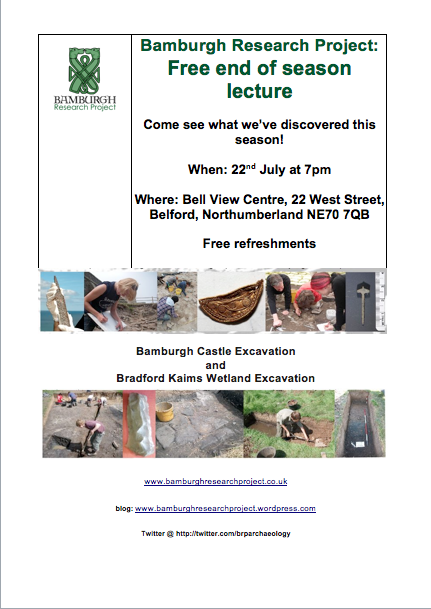Becky Scott – Assistant Supervisor (Geoarcheology) and PhD Candidate, University of Reading
Following on from our blog post about the geophysical survey carried out at the Kaims this year, we have been busy ‘ground-truthing’ the anomalies seen just to the North of Trench 6 – that is, identifying whether the magnetic anomalies seen on the survey are archaeological features or not. Of course, like most endeavors, we have had varying degrees of success! The first few test pits that were dug contained nothing but colluvium (sediment that has been deposited downslope, often known as hill or slope wash) even after digging up to a metre. We then decided to take some cores around the area that showed the magnetic anomalies to the North of Trench 6 using the Dutch auger, which is essentially a long pole about 1 metre long with a T-handle and a screw-like head at the bottom which collects and retains sediment. Dutch augers are particularly useful for hard and wet sediments so worked very well through our silty clay colluvium. After taking a number of cores (with the excellent help of our two Young Archaeologists Club competition winners!) we eventually came up with some lovely layers of charcoal and burnt material, so we set to work digging three more test pits. Two of these test pits were more much more successful, particularly Test Pit 75 which showed a charcoal layer almost 30cm thick (see Figure 1 below).

Figure 1. SE-facing section of TP75 showing three very distinct layers: Top soil, colluvium and a ~30 cm thick charcoal and stone rich layer.
Test Pits in the wider landscape
As well as ground-truthing the results of the geophysical survey, we have also been collecting samples for geoarchaeological analysis from some larger test pits dug by our new friend, The Big Digger. For those unfamiliar, geoarchaeology is an approach to archaeology which utilises techniques from the earth and environmental sciences to answer archaeological questions. In real life it mostly involves getting really, really muddy and pondering sediment sequences for long periods of time…
The main aim was to take samples from the colluvium in the wider landscape (identified during coring by Dr. Richard Tipping and Coring Supervisor Anna) for radiocarbon and pOSL (portable Optically Stimulated Luminescence) dating and micromorphology (the study of in-situ soils and sediments in thin section) to provide us with a proxy for human activity in the immediate area (see Figure 2 below). Colluvium results from human activity, particularly agriculture, and therefore can tell us about past agricultural processes in the wider landscape as it represents a period of soil erosion due to ploughing, over-grazing, and the removal of trees. Under gravity these sediments are then transported downslope. Sometimes, if geoarchaeologists are lucky, ancient soils will be preserved underneath the colluvium allowing us to infer a period of stability and identify the environmental conditions before the land was cleared. The nature of the colluviation also gives information about what processes caused it to erode, and how high the energy of its erosion was.

Figure 2. Students Oda and Daniel taking OSL samples in the extended section of T6 with Anna and Becky, and Director Paul also working hard in the background. Samples for pOSL were taken vertically down the sequence from the section by inserting tubes into the face of the section, removing gently and quickly securing with tape to ensure no light entered the samples. They were then labelled with a sample number and an arrow indicating the end that had not been exposed to light, ready for laboratory analysis.
Figure 2. Students Oda and Daniel taking OSL samples in the extended section of T6 with Anna and Becky, and Director Paul also working hard in the background. Samples for pOSL were taken vertically down the sequence from the section by inserting tubes into the face of the section, removing gently and quickly securing with tape to ensure no light entered the samples. They were then labelled with a sample number and an arrow indicating the end that had not been exposed to light, ready for laboratory analysis.
pOSL will hopefully allow us to identify the rates of erosion in the area, with the radiocarbon dates from the peat below effectively acting as an ‘anchor’ to identify when this erosion (and therefore agricultural clearance) began. Once the thin sections are made, micromorphology will allow us to identify the depositional and post-depositional processes occurring at the microscale.


















